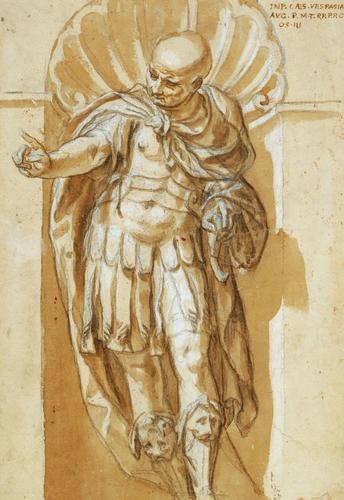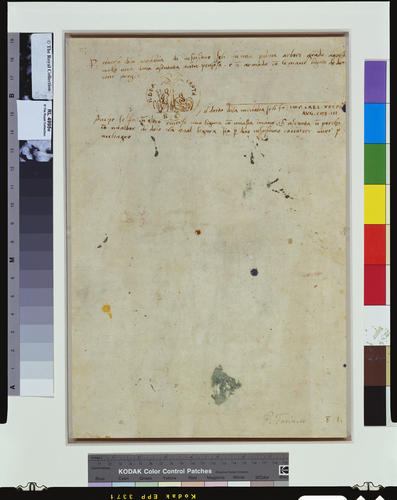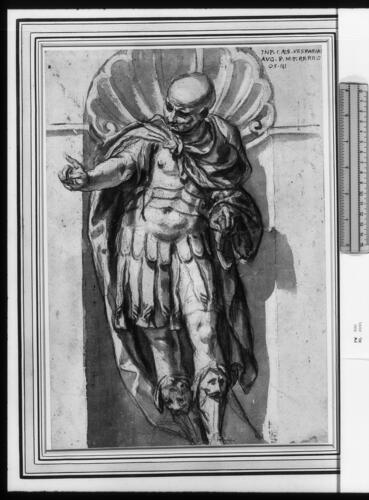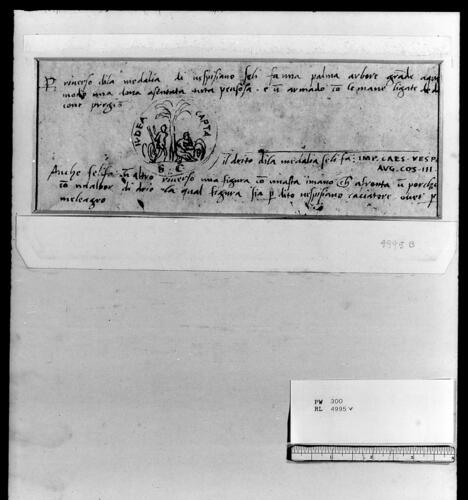-
1 of 253523 objects
The Emperor Vespasian c.1550-1600
Black chalk, pen and ink, brush and ink, and white heightening on paper washed pale brown. Verso: Pen and ink | 39.4 x 27.0 cm (sheet of paper) | RCIN 904995
-
A drawing of a man in antique garb, standing in a niche, gesturing to the left. Inscribed by the artist at upper left, INP.CAES.VESPASIA.. / AUG.P.M.T.R.P.P.P.C. / OS. III.
The drawing is one of a set of eight by Farinati in the Royal Collection depicting great men from ancient history: others show the Emperors Vitellius and Julius Caesar, Alexander the Great (three drawings), King Sapor of Persia and Attila the Hun. There are similar studies of the Emperor Antoninus Pius in the Ashmolean; of Mithridates, King of Pontus, in Edinburgh; and of Vitellius in Washington,, NGA 1975.71.3. All of these figures are shown standing in niches or on plinths, or seated on architectural elements, suggesting that they were intended to be painted illusionistically as part of an interior decoration scheme - most probably of a library, as libraries were traditionally furnished with portraits of great men. Farinati painted in the Palazzo Guarienti alla Bra in Verona a room with depictions of the Twelve Caesars (emulating Titian’s cycle in the Palazzo Ducale), but the drawings in the Royal Collection, which include figures other than Roman emperors, must relate to a different project.
In inscriptions on both sides of the sheet (and on several others in the series), Farinati considers an associated medal of the emperor. The lettering on the recto is derived from a coin of the emperor, but on the verso of the sheet Farinati suggests two possible medals of his own invention (see D. Scrase in The Genius of Venice, exh. cat., London, RA 1983, p.256). Alongside a sketch of a medal with two figures either side of a palm tree and the words IUDEA CAPTA SC is the inscription P[er] riverso dila medalia di vespisiano seli fa una palma arbore gra[n]de de aquesto / modo una dona asentata tuta pensosa e u[n] armado co[n] le mane ligate di die[…] / come pregio[niero] / il drito dila medalia seli fa: IMP. CAES. VESPASi / AUG. COS. III. / Anche selifa u[n] altro riverso una figura co[n] unasta imano ch[e] afronta u[n] porche / co[n] unalbor di drio la qual figura sia p[er] dito vespisiano caciatore over p[er] / meleagro.
Also on the verso is William Gibson's ascription and price mark P. Farinato 8.1. Farinati’s drawings were esteemed by seventeenth-century English collectors, and the Royal Collection now holds about fifty sheets by him and his followers. Fourteen of these bear an inscription in a hand identifiable as that of the dealer William Gibson, and it is probable that most, if not all, of the Farinatis were acquired during the reign of Charles II. A list of albums at Kensington Palace in 1727 includes one volume entirely of drawings by Farinati, with others in a miscellaneous album.
Catalogue entry adapted from M. Clayton, The Art of Italy in the Royal Collection: Renaissance and Baroque, London, 2007, no. 87.Provenance
William Gibson (his price mark); probably acquired by Charles II. Royal Collection by c.1810 (Inventory A, p. 117, Paolo Farinati, 'A spirited manner & not wanting in Invention but not correct in his Drawing')
-
Creator(s)
Acquirer(s)
-
Medium and techniques
Black chalk, pen and ink, brush and ink, and white heightening on paper washed pale brown. Verso: Pen and ink
Measurements
39.4 x 27.0 cm (sheet of paper)
Category
Object type(s)
Other number(s)



